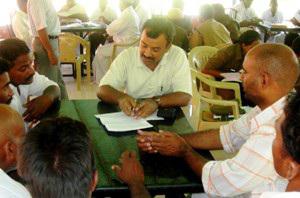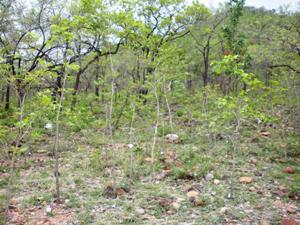Sidhanand Kukrety
This project aims to develop a community supported ecological restoration strategy with inputs of restoration techniques, species distribution modelling and stakeholders perception identified through research.

Interaction with stakeholders.
Red Sanders (RS); (Pterocarpus santalinus L), is an endemic, endangered and geo-botanically confined, highly valuable timber yielding tree species restricted to approximately 0.2 million hectares in southern India. Anthropogenic and other abiotic pressures have led to fragmentation and slow but steady degradation of RS landscape. Concerted steps to restore its shrinking extent and degraded habitat backed with scientific inputs, and stakeholder’s involvement will be a right step in saving this species from extinction. This study is geared towards understanding and documenting the present status of RS forests and the possibility of its restoration in areas identified through modelling with involvement of local communities and stakeholders. The planned activities are as follows:

Red sanders research area.
I. Species Distribution Modelling (SDM): The geobotanical studies suggest the occurrence of RS on specific mineral types. Therefore, the information pertaining to the historical extent is vital for restoration planning and spread of RS. SDM is one such tool that helps the ecologists to identify the spread of a species. Due to its unique disposition, the first aim of this study is to develop a SDM to identify its distribution.
II. Identification of Best Restoration Technique: Having identified the historical extent through modelling, the next logical step is to plan and expand the restoration activity in the areas identified. Young RS regeneration is known to suffer high mortality in wild on account of wildfire, drought another biotic pressures. For successful restoration, high survival of RS seedlings is a prerequisite. This provides rationale for the second objective – ‘to identify the most suitable restoration technique for the survival of RS seedlings in wild’. Field experiment for identifying effect of various treatments on survival of RS seedlings in wild will be carried out to identify the treatment with maximum efficacy.
III. Stakeholder’s perception: Past research has shown that eliciting stakeholder's perception and incorporation in plan reduces conflicts and improves the success of restoration. This becomes more important in a developing country like India where rural communities are highly dependent on forests for their livelihoods. Using Analytic Hierarchy Process (AHP), we plan to elicit stakeholder perception in groups comprising of landowners, NGOs, local forest department officials and administrators.
We are hopeful that the results of this project will help the forest department in formulating long term strategies and policies that would be geared towards long term restoration of RS.